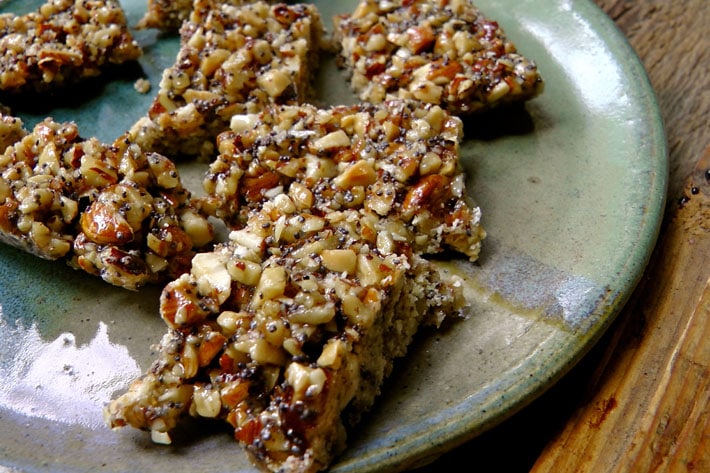This past summer I traveled to France to meet my husband’s family. I’ve been reminiscing about that trip a lot lately, especially because of my video series on HerbMentor.com, Plants in France. This series narrates videos and photos I took in France and shares the French culture of these plants.
In case you aren’t an HerbMentor.com member I thought I would share a taste of France with you.
Some of my favorite memories from my trip to France were gazing from the train window watching the beautiful fields of corn poppies fly by. Of course I am not the first to notice this beautiful phenomenon. Art impressionist Claude Monet made these fields famous in many of his paintings.

What’s in a name?
The French call this plant Coquelicot (Coke-lee-coh), which is a derivation of the rooster crow. In english, roosters make the sound of cockledoodledo, but in French the sound that the rooster makes is Cocorico. Hence, the name coquelicot.
The genus for this plant, Papaver, may have been derived from the celtic language where papa means porridge or gruel. Poppy is said to have gotten this genus name because they used to add parts of the poppy to children’s porridge to help them sleep at night.
“Whoa!” You might say. “Giving poppies to children!!! What kind of website is this?!”
Well, actually the corn poppy (Papaver rhoeas), which is the poppy growing abundantly in the agricultural fields of France, does not contain the same opiates as the opium poppies (Papaver somniferum).
Corn poppies were commonly used as medicine and were even called the safe opium of the people (nevertheless, it is not for children less than three years old.)
Here’s one explanation of how the English word “poppy” came to be. It was once popular for children to make little dolls out of the poppy flowers. The word for doll in French is poupée, which over time became poppy in English. This summer my husband made me some of these poppy dolls. Adorable! The dolls are pretty cute too.


Corn poppies in history
No one really knows where the poppy plant originated, but they have been associated with agriculture and grains for a very long time.
Poppies are really prevalent in Greek mythology. Hypnos, the Greek god of sleep, was represented by a crown made of poppies.

Poppies are found in Egyptian tombs and poppy seeds were also used as a condiment in ancient Egypt.
Poppy is an international symbol for commemorating wars and other places of blood shed. One reason for this is the bright red color of the flowers symbolizing blood.
Another reason the poppy commemorates wars is because in Europe it easily colonizes the disturbed soils of mass graves. Thus it is said that the poppy fields covering the soldiers’ graves is the blood of the fallen. “In Flanders Fields” is a famous poem written in 1919 that begins with
In Flanders fields the poppies blow
Between the crosses, row on row,
That mark our place; and in the sky
The larks, still bravely singing, fly
Scarce heard amid the guns below.
Edible and medicinal uses of the seeds
The seeds and seed capsules are also used as food and medicine. One recipe I learned in France called for a decoction of 8-10 seed capsules per liter of water, bring to a simmer for 10 minutes, and take 3-4 tablespoons a day. It can also be added to warmed milk in the evening to give a peaceful sleep to children. Poppy seeds are also used to help quiet coughs.
You are probably familiar with the tiny black poppy seeds being used for culinary purposes. They add a nutty flavor to foods and are commonly added to bagels and lemon breads. Generally the poppy seeds that are used for culinary reasons come from the opium poppy, but there is only trace amounts of opiates in the seeds, not enough to raise health concerns.
Nougatine: A Poppy Seed Recipe
This recipe is part treat and part medicine and is based on a French recipe called nougatine. While these can simply be enjoyed as a sweet treat, the demulcent and expectorant qualities of the honey and relaxing nervine qualities of the poppy seeds make this helpful for coughs.
What you’ll need…
- 1/2 cup of honey
- 1 cup of chopped nuts such as hazelnuts, walnuts, almonds
- 2 heaping teaspoons of poppy seeds
Place the chopped nuts and poppy seeds in a pan and roast them at 450 for about 10 minutes. Check on them every couple of minutes to stir them and check their progress. They are done when the nuts begin to brown and release a pleasant smell.


Next, melt the honey in a medium saucepan on really low heat. Once it is warmed and syrupy then add the nuts and seeds.


Cook on low heat for about ten minutes, stirring frequently.
Pour this mixture into a pan and then cut into bite size pieces. It will harden as it cools.
I released a video about corn poppies this month on HerbMentor.com that includes information about using the petals and leaves for food and medicine. This is one of my favorite projects since it combines two of my passions in life. France and Plants!
Enjoy these treats!










